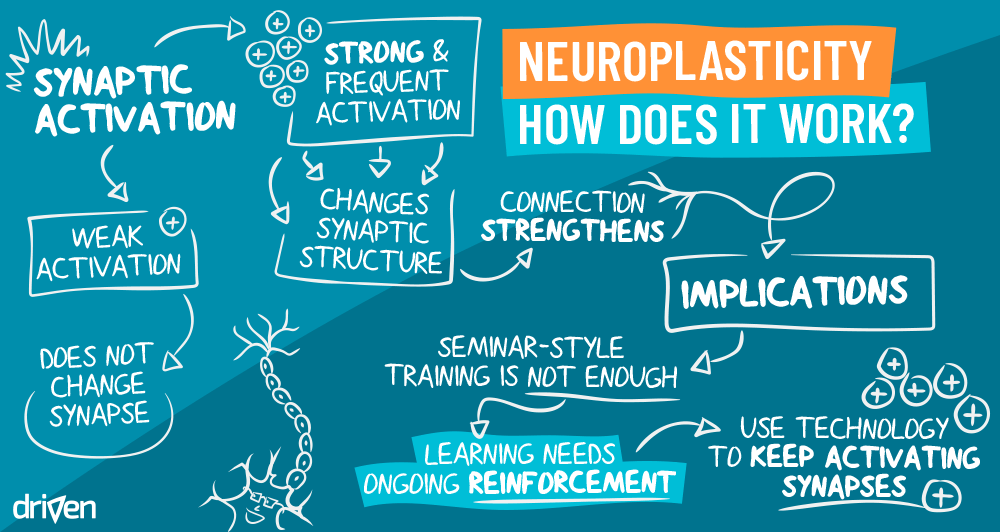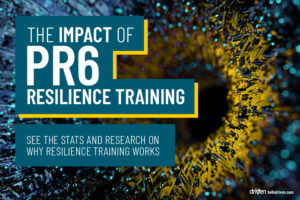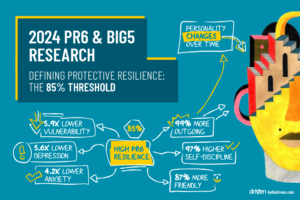Build resilience over time with the Driven app. Download now.
Plasticity – Not just about new neurons
How neuroplasticity works: plasticity is the ability of the brain to change. Of course, the brain is made up of about 100 billion neurons, each with thousands of connections to each other. The organisation of these connections encodes your beliefs, memories, habits, behaviours, and more. From birth, this organisation constantly changes – the exciting aspect of this is that we can purposefully change our neural organisation through directed effort.
But how does this happen?
One aspect of plasticity is neurogenesis. This is when new neurons are born from stem cells within the brain, which can then form new circuits. Neurogenesis surprisingly only happens in a few areas in the brain. One area is the hippocampus which needs a lot of new neurons because it encodes new memories. Another area is the olfactory bulb, which allows us to sense smells.
Contrast this with the prefrontal cortex. Sitting at the front of your brain, the prefrontal cortex is what performs high level abstraction and ‘smart’ thinking. Interestingly, the prefrontal cortex is not capable of neurogenesis. Essentially from an evolutionary standpoint, the brain figured it is as smart as it needs to be, but there will be many important new smells to identify! This is a reminder to us of just how wired the brain is towards survival. We need to keep in mind that it takes active effort for us to overcome our survival instincts and rise above our base nature.
How does the smart brain adapt?
Fortunately, the prefrontal cortex can still adapt by altering its synaptic connections. What does this mean? Each neuron connects to the next neuron through synapses. These are tiny extensions that reach out and send signals between neurons. We might think of neurons and their synaptic connections like a simple electrical circuit where if one neuron fires, the next one fires, and the next, etc. But it’s actually quite different.
In fact, one synaptic connection is not strong enough to trigger the firing of the next neuron. Instead, the signal from one synapse is very weak – we need tens to hundreds of synapses to fire close together to trigger the next neuron to fire. What’s more, while electricity is what conducts the signal along the neuron, the way the signal jumps to the next neuron is mainly chemical. Through a host of different neurotransmitters that the first neurons release, there are many different effects that it can have on the next neuron.
For example, some neurotransmitters make it more likely for the next one to fire, and some make it less likely to fire. Some even change how the next neuron operate. This is where we need to look at the fascinating world of receptors.
It's all in the reception
For our quick crash course in plasticity, we’ll look at one of the most abundant neurotransmitters – glutamate. This transmitter is mainly excitatory, meaning it usually makes the next neuron more likely to fire. The way it does this is by getting released from the synapse of the first neuron and then binding with receptors at the synapse of the second neuron. There are many different types of receptors with different functions, so let’s look at two that will help you understand plasticity a bit better. In particular, the AMPA and NMDA receptors. These receptors both bind with glutamate. When this binding happens, the AMPA receptor opens up and lets sodium ions in. As the positively charged sodium ions rush in, the second neuron starts to depolarise. If it depolarises enough, it will trigger a cascade effect, causing the second neuron to fire.
What up with NMDA?
Meanwhile, NMDA has also bound with glutamate, but it has a larger magnesium ion blocking the opening. If the first neuron only fires weakly, then the magnesium ion stays stuck and blocks the NMDA pore.

However, if the first neuron fires strongly and in high frequency, then the depolarisation through the AMPA receptors is strong enough to pop the magnesium out like a cork.
With NDMA now open, it lets in more sodium, but also lets in calcium. This is critically important, because the sudden influx of a lot of calcium triggers a process through which the second neuron deposits more AMPA receptors at the synapse. Now this is really cool – these AMPA receptors were lying dormant inside the synapse previously, though now they are activated at the cell membrane, meaning that the synapse is now more sensitive that before!

The calcium ions also affect other processes inside the cell, leading to the gene transcription for the creation of new synapses in a process called synaptogenesis. Sitting around the two synapses are glial cells called astrocytes. All this activity of firing between the synapses cause the astrocytes to get more involved in clean-up, making the connection even stronger. These additional processes are important for long term strengthening of the synaptic connections.
This is physical change
Here you can see your brain physically changing. Through activating specific pathways more frequently, you make these synaptic connections stronger and more likely to fire in the future. Of course, the reverse also works, where ongoing weak firing causes the second neuron to move active AMPA receptors away from the membrane, making the synaptic connection weaker. This is how you can break habits!
Frequent activation gradually adds more AMPA receptors and modulate other receptors and transmitters that make the activated neural pathway more natural. The result is that the effortful behaviour starts to become your new default behaviour. Meanwhile old habits fade away as AMPA receptors are removed and synapses eventually disconnect. Importantly, you can’t just make all these synaptic connections super strong in one day – pathway reorganisation takes time and effort.
Implication for training and coaching
The lesson here is that changing the brain takes constant, repeated effort. The implication is that our usual preference for holding and attending seminars is not efficient in producing lasting results. Even if you have a big “Aha” moment in a seminar, that single moment doesn’t yet meaningfully change the brain – it is only through conscious effort to put the new knowledge into practice that exposes those new AMPA receptors.
Therefore, if we truly want to make a change, we need to take this information into account. We need to find a way to deliver learning over time to reinforce synaptic change. However, even though coaches, clinicians and even businesses may understand this, there has always been a major cost impediment – getting someone in often enough to facilitate this type of change is expensive.
Digital augmentation provide new options
However, we live in an amazing new world of digital augmentation. Through some clever integration of expertise, we can accomplish much more now than we could in the past. This is why I have focused my attention on using this integrative approach to build an advanced resilience training tool that is time-efficient, cost-efficient, and brain-efficient. We accomplish this by delivering training in small, efficient chunks to learners, making training digestible, while constantly firing those synapses to build stronger neural pathways.
We already have over 100 businesses, coaches and clinicians using our platform with great success to provide enhanced resilience and wellbeing training that takes advantage of understanding neural mechanics. Interested in joining?
- Coaches & clinicians – Our platform augments your services by expanding the attention that you can provide to your clients. Check out our resilience workshop, created specifically for coaches & clinicians, where you will learn about the program content, the platform, and how you can use technology to advance your practice.
- Individuals and businesses – Want to try a brain-efficient program to improve resilience yourself or for your business? Get in touch to try it out: info@hellodriven.com
All the best,
Jurie



